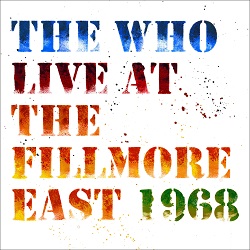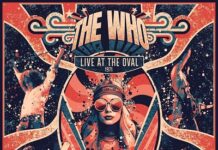Live At Leads, the Who’s first official live album released in 1970, accurately captures the band’s fiery chemistry, precociously executed, flavored with pure bluster, sweat, bravery and recklessness to make it all the more engaging. Long considered one of the greatest live albums ever released, Live At Leeds now has a little competition in a long lineup of Who live releases. Live At The Fillmore East 1968, recorded in April 1968 at Bill Graham’s Fillmore East in New York, predated Tommy by a year and positioned the Who at the precipice of one of rock’s most pivotal eras — when concerts transformed from teeny bopper fests bubbling over with screaming prepubescent girls to heady, mind-expanding, life-altering experiences.
The stage became a place where aural visions were worked out and brought together, often spontaneously and completely on the fly. Everyone in the room — audience members, promoters, managers, roadies, groupies, security — looked on in fervent anticipation of what could possibly happen next. As a recent Los Angeles Times article put it, 1968 was the “birth of arena rock,” and the Who were, by all accounts, smack dab in the middle of the revolution. They had already moved on from the Smother Brothers Comedy Hour to Monterey. The Who’s notorious antics got them noticed; their rise as a molten white-hot band with chops gave them wings.
Put Live At The Fillmore East 1968 up next to Live At Leeds, and you’ll notice inherent differences in the way the band approaches the material. At the Fillmore, both Eddie Cochran’s “Summertime Blues” and Johnny Kidd’s “Shakin’ All Over,” arguably the Who’s most omnipotent covers, are scrappier and looser than their Leeds counterparts. The addition of two other Cochran songs —”My Way” and “C’mon Everybody” — sweetens the rootsy Fillmore set. Similar assessments could be applied to much of the material on this release, as the Who’s appetite for bombastic, four-on-the-floor candor is at the heart of the band’s canon.
The Who stays in bounds for simpler fare like “Little Billy,” “I Can’t Explain,” “I’m A Boy” and “Boris The Spider.” Its on “Relax,” the band, particularly guitarist Pete Townshend, first stretch out and improvise their way to the bridge. Instead of shilling speed or spellbinding trickery, Townshend employs texture and feedback over a rumbling John Entwistle and Keith Moon rhythm section to get the point across. The Who’s approach to free-form jamming was not as blues infused as Cream or Hendrix, nor as beatific as the Grateful Dead, but it rang true and deep enough to make you want to ingest each and every nuance.
Adding gravity, Townshend introduces “A Quick One, While He’s Away” as the band’s “brand” and alludes to how future Who records would be presented. In that moment, it becomes obvious the guitarist was already headlong into piecing Tommy together, and he had plenty of stories to tell. On Live At Leeds, bits and pieces of Tommy were thrown into a 15-minute version of “My Generation.” The 33-minute version on Live At The Fillmore East 1968 is dirtier, rawer, without the cushion of other songs to extend it. This is the Who at their most visceral, paving the way to subsequent game-changers like Woodstock, Tommy and Live At Leeds. The masses would learn what the folks crammed into the Fillmore East for those two nights that followed the tragic assassination of Martin Luther King, Jr. already knew: The Who were one of the greatest live bands in rock and roll.
~ Shawn Perry




















